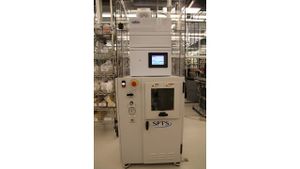Difference between revisions of "HF Vapor Etch"
Jump to navigation
Jump to search
(→About) |
|||
| (27 intermediate revisions by the same user not shown) | |||
| Line 1: | Line 1: | ||
{{tool|{{PAGENAME}} |
{{tool|{{PAGENAME}} |
||
| − | |picture= |
+ | |picture=IMG_2416_1.jpg |
|type = Dry Etch |
|type = Dry Etch |
||
|super= Mike Silva |
|super= Mike Silva |
||
| − | |phone=(805)839- |
+ | |phone=(805)839-3918x219 |
|location=Bay 2 |
|location=Bay 2 |
||
|email=silva@ece.ucsb.edu |
|email=silva@ece.ucsb.edu |
||
|description = Vapor HF Etcher |
|description = Vapor HF Etcher |
||
| − | |manufacturer = [http://www. |
+ | |manufacturer = [http://www.spts.com/products/release-etch/uEtch/ SPTS Inc] |
|materials = |
|materials = |
||
|toolid=31 |
|toolid=31 |
||
}} |
}} |
||
= About = |
= About = |
||
| − | The applications of this tool are mainly in MEMS-device fabrication areas (releasing a MEMS structure by etching a sacrificial |
+ | The applications of this tool are mainly in MEMS-device fabrication areas (releasing a MEMS structure by etching a sacrificial SiO<sub>2</sub> layer below) with the use of Al<sub>2</sub>O<sub>3</sub>, Al or some other metal as an etch mask at 45<sup>o</sup>C. The tool uses vapor HF (VHF), EtOH (Ethanol vapor is an Alcohol-based one, ionizing the HF and activating etching, influencing within wafer etch uniformity, and being most compatible with VHF), and N<sub>2</sub> gases and can process small sample(s) (on a 8<sup>"</sup> Si carrier wafer) up to an 8<sup>"</sup> wafer. There are 5 standard etch recipes installed in the tool with the SiO<sub>2</sub> etch rate from low to high. The SiO<sub>2</sub> under etch rate is from ~10nm/min to ~350nm/min. |
=Documentation= |
=Documentation= |
||
| − | *[[media: |
+ | *[[media:SPTS-Primaxx_uEtch_Presentation-a.pdf|System Manual]] |
| − | *[[media: |
+ | *[[media:SPTS-Primaxx_uEtch_Presentation-b.pdf|System Manual]] |
| + | *[[media:25-Dry_Etch_of_Unaxis_ICP-grown_SiO2_using_Vapor_HF_tool-a.pdf|Si Etching Profile & Results]] |
||
| + | *[[media:26-Dry_Etch_of_Unaxis_ICP-grown_SiO2_using_Vapor_HF_tool-b.pdf|Si Etching Profile & Results]] |
||
Latest revision as of 15:51, 31 January 2014
| |||||||||||||||||||||
About
The applications of this tool are mainly in MEMS-device fabrication areas (releasing a MEMS structure by etching a sacrificial SiO2 layer below) with the use of Al2O3, Al or some other metal as an etch mask at 45oC. The tool uses vapor HF (VHF), EtOH (Ethanol vapor is an Alcohol-based one, ionizing the HF and activating etching, influencing within wafer etch uniformity, and being most compatible with VHF), and N2 gases and can process small sample(s) (on a 8" Si carrier wafer) up to an 8" wafer. There are 5 standard etch recipes installed in the tool with the SiO2 etch rate from low to high. The SiO2 under etch rate is from ~10nm/min to ~350nm/min.
